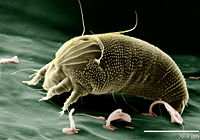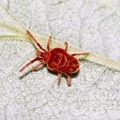Mite
Mites, including ticks, belong to the subclass Acarina (also known as Acari) and the class Arachnida. Mites are among the most diverse and successful of all the invertebrate groups. They have exploited an incredible array of habitats, and because of their small size (most are microscopic) most go totally unnoticed. Many live freely in the soil or water, but there are also a large number of species that live as parasites on plants or animals and even some that feed on mold.
Acarina or Acari are a taxon of arachnids that contains mites and ticks. The diversity of the Acari is extraordinary and its fossil history goes back to the Devonian era. As a result, acarologists (the people who study mites and ticks) have proposed a complex set of taxonomic ranks to classify mites. In most modern treatments, the Acari is considered a subclass of Arachnida and is composed of 2-3 orders or superorders: Acariformes, Parasitiformes, and Opilioacariformes. The latter is often considered a subgroup within the Parasitiformes. The monophyly of the Acari is open to debate and the relationships of the acarine orders to other arachnids is not at all clear.
Most acarines are minute to small (e.g. 0.08–1.0 mm), but the largest Acari (some ticks and red velvet mites) may reach lengths of 10–20 mm. It is estimated that over 50,000 species have been described (as of 1999) and that a million or more species are currently living. The study of mites and ticks is called acarology (from the Greek: ἀκάρι, akari, a type of mite; and λόγος, logos, "knowledge")[1], and the leading scientific journals for acarology include Acarologia, Experimental and Applied Acarology and International Journal of Acarology.
Morphology
Mites are members of Arachnida and, as such, should have a segmented body with the segments organised into two tagmata: a prosoma (cephalothorax) and an opisthosoma (abdomen). However, only the faintest traces of primary segmentation remain in mites, the prosoma and opisthosoma are insensibly fused, and a region of flexible cuticle (the cirumcapitular furrow) separates the chelicerae and pedipalps from the rest of the body. This anterior body region is called the capitulum or gnathosoma and is also found in the Ricinulei. The remainder of the body is called the idiosoma and is unique to mites. Most adult mites have four pairs of legs, like other arachnids, but some have fewer. For example, gall mites like Phyllocoptes variabilis (superfamily Eriophyioidea) have a wormlike body with only two pairs of legs; some parasitic mites have only one or three pairs of legs in the adult stage. Larval and prelarval stages have a maximum of three pairs of legs; adult mites with only three pairs of legs may be called 'larviform'.
Some of the plant pests include the so called spider mites (family Tetranychidae), thread-footed mites (family Tarsonemidae), and the gall mites (family Eriophyidae). Among the species that attack animals are members of the Sarcoptic Mange mites (family Sarcoptidae), which burrow under the skin. Demodex mites (family Demodicidae) are parasites that live in or near the hair follicles of mammals, including humans. Perhaps the best-known mite, though, is the house dust mite (family Pyroglyphidae).
Insects may also have parasitic mites. Examples are Varroa destructor which attaches to the body of the honeybee, and Acarapis woodi (family Tarsonemidae), which lives in the tracheae of honey bees. There are hundreds of species of mites associated with other bee species, and most are poorly described and understood. Some are thought to be parasites, while others beneficial symbionts.
There are over 45,000 described species of mites[1]. Scientists believe that we have only found 5% of the total diversity of mites. Mites are believed to have existed for around 400 million years.
The scientific discipline devoted to the study of ticks and mites is called acarology.
The tropical species Archegozetes longisetosus is one of the strongest animals in the world, relative to its mass (100 μg): It lifts up to 1182 times its own weight, over five times more than would be expected of such a minute animal (Heethoff & Koerner 2007).
Systematics
The phylogeny of the Acari is still disputed and several taxonomic schemes have been proposed for its classification. Most workers agree that the Acari contains two separate lineages: the Acariformes (also Actinotrichida) and the Parasitiformes (also Anactinotrichida). However, some workers treat these groups as superorders and others as orders.
- Acariformes is the most diverse order/superorder of mites.
- Order/Suborder:
- Trombidiformes - plant parasitic mites (spider mites, peacock mites, gall mites, red-legged earth mites, etc.), snout mites, chiggers, hair follicle mites, velvet mites, water mites, etc.
- Sarcoptiformes - oribatid, endeostigmatan, and astigmatan mites
- Endeostigmata - basal sarcoptiform lineages
- Oribatida - oribatid mites, beetle mites, armored mites (also cryptostigmata)
- Astigmata - stored product, fur, feather, dust, and human itch mites, etc.
- Parasitiformes is the order/superorder that contains the ticks and a variety of mites.
- Order/Suborder:
- Mesostigmata - bird mites, phytoseiid mites, raubmilben
- Ixodida - hard and soft ticks
- Holothyrida - holothyrans
- Opilioacariformes is a small order or suborder of parasitiform mites that are superficially similar to harvestmen (opiliones, hence their name).
- Obsolete names:
- Opilioacarida
- Notostigmata
See also
- Harvest mite (chigger)
- Mold mites
- House dust mite
- Miticide
- Diseases of the honey bee
- Anti-itch drug
- Category:Antiparasitic_agents
ReferencesISBN links support NWE through referral fees
- Heethoff, M. & Koerner, L. (2007): Small but powerful - The oribatid mite Archegozetes longisetosus Aoki (Acari, Oribatida) produces disproportionate high forces. J. Exp. Biol. 210(17): 3036-3042. DOI:10.1242/jeb.008276 (Abstract)
External links
- PARASITIC MITES OF HUMANS University of Kentucky
- Red velvet mite - Trombidium sp. diagnostic photographs
- Worldwide honey bee decline due to mite infestations - article, photographs
- Control of the citrus rust mite hosted by the UNT Government Documents Department
- Yellow mite (Tydeidae), Lorryia formosa.jpg
Yellow mite
Lorryia formosa
Credits
New World Encyclopedia writers and editors rewrote and completed the Wikipedia article in accordance with New World Encyclopedia standards. This article abides by terms of the Creative Commons CC-by-sa 3.0 License (CC-by-sa), which may be used and disseminated with proper attribution. Credit is due under the terms of this license that can reference both the New World Encyclopedia contributors and the selfless volunteer contributors of the Wikimedia Foundation. To cite this article click here for a list of acceptable citing formats.The history of earlier contributions by wikipedians is accessible to researchers here:
The history of this article since it was imported to New World Encyclopedia:
Note: Some restrictions may apply to use of individual images which are separately licensed.
- ↑ D. E. Walter & H. C. Proctor (1999). Mites: Ecology, Evolution and Behaviour. University of NSW Press, Sydney and CABI, Wallingford. ISBN 0-86840-529-9.









